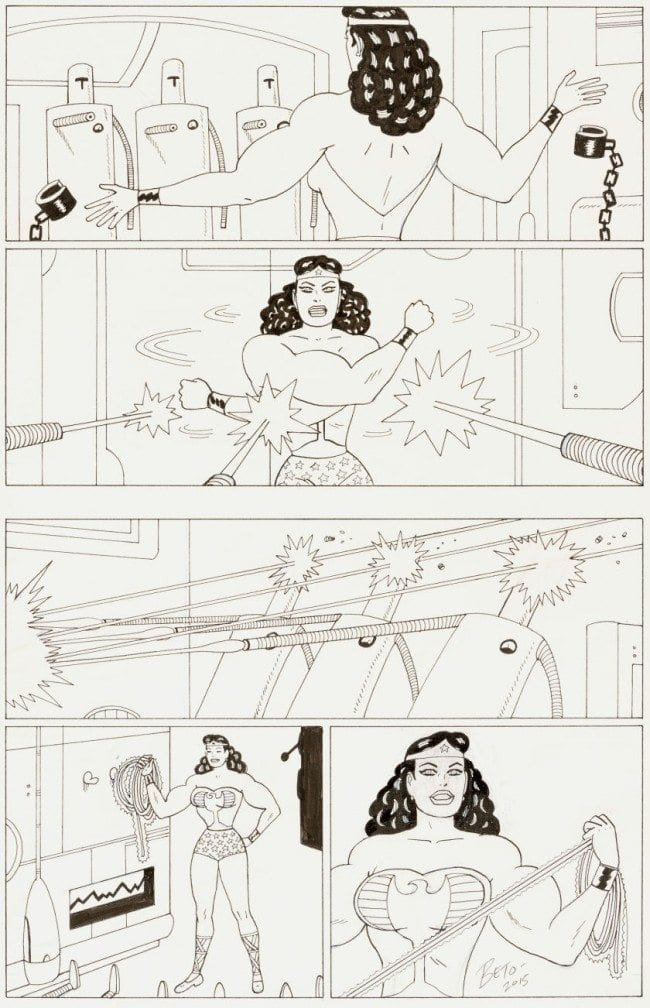Today, we are happy to present the Comics Journal debut of Tasha Robinson, who has conducted a lengthy interview with Scott McCloud about the ending of The Sculptor, which she believes is "easily its most controversial and difficult element." If you don't like spoilers, avoid this interview until you've read the book. Here's a short sample of their talk:
You said you don’t mean for his final work to come across as a masterpiece, though it’s hard to see that from the story.
No, I don’t. Though I don’t want to say one way or another. I don’t even think it’s an interesting question. [Laughter.] How it stands up as art is completely beside the point. He’s keeping a promise, and creating something that can’t be ignored in the bargain. But almost accidentally. Almost as a proxy for her.
The proxy aspect is bothersome. It feels like David’s trying to recreate Meg, as he has at so many other points in the story, for various reasons. And his last act is looping back to this thing he’s done multiple times in the past. It feels like after all the growth he’s been through, he still hasn’t learned much.
I don’t think that’s true. I think he’s learned quite a lot. But what he chooses to make—it’s two things. It’s her, and we’ve established that he has this preternatural memory for detail, so we hope he would have the chops to do this. That was important from the get-go. But in the end, all he can do is honor his promise to her. And what he chooses as an image is something from their recent past, when she’s outside St. Patrick’s cathedral, tossing the baby in the air. But it’s also about what she said to the baby in that scene. That’s his way of also acknowledging that it’s all down here.
It’s hard for me to explain why, for me, it feels like the right image. But I think he’s learned a lot. The only problem is that he can’t apply it all. He can’t apply the acceptance he’s learned, because that’s been taken away from him. I suppose he’s going to a smaller place inside his mind, of just being with her. It’s one last communion, one last message, one last interaction with her, almost to the point where she still exists for him. She’s still there, suspended in that moment. Something he’s been doing all along is to try to stop time, to stop the clock. This time he’s just stopping it on her. He knows he can’t bring her back. He can honor a commitment, he just can’t conjure her back to life, any more than Harry could. But he can at least, in his last moments, go back to a place where she’s still there.
We are also publishing Brandon Soderberg's review of the new Guy Colwell collection, Inner City Romance:
The sociopolitical parables of Inner City Romance, an underground comic published between 1972 and 1978 are pure, uncut products of cagey, post-Sixties radicalism. Across five issues, cartoony-photorealist from the Bay Guy Colwell shakes off his free love hangover and wrestles with the disillusionment that pops-up once idealism hits a wall. More often than not, an Inner City Romance story ends with a shocking moment of politically loaded brutality that acknowledges how much work still needs to be done. There's no other underground comic quite like this one.
Let's start with Colwell at his most successfully blunt: "Sex Crime," a didactic stunner from issue #5. We witness a woman raped in an alley by a white man, only to be stopped by another white man who also takes it upon himself to assault her. She shoots the second rapist, and then, an African-American man, dressed in a Black Panther turtleneck comes to her aid after hearing the shots and the woman shoots and kills him without hesitation, a big bullet hole blasted through his chest. The whole thing is drawn in a reedy, EC Comics pop-expressionist style, but devastating in its neorealist moralizing. And although this black character is a clear cut, tragic victim of circumstance, Colwell still doesn't indulge the idealizing-the-underclass-and-minorities hippie-dippie nonsense common amongst even engaged white outsiders. Spending nearly two years in prison for non-cooperation during the draft presumably added a lived-in pragmatism to his characterizations.
Meanwhile, elsewhere:
—News. Two Turkish cartoonists, Bahadır Baruter and Özer Aydoğan, have just been sentenced to 11 months in prison over a magazine cover that supposedly "insults" Turkish President Recep Tayyip Erdoğan. The CRNI has more background on recent government attempts to persecute Turkish cartoonists.
Eleven staff members of Charlie Hebdo are asking for stock options in the magazine.
Zunar has announced he will seek legal action against Malaysian police for returning damaged art.
After a recent controversy about shelving Tintin in America in a Winnipeg branch of Chapters, the same book has now been pulled from the Winnipeg public library system, pending review.
—Interviews & Profiles. The always great conversationalist Dylan Horrocks is the latest guest on Inkstuds.
Kaulie Lewis spoke to Alison Bechdel shortly after her MacArthur grant win.
Alex Dueben talks to Stan Sakai about his planned return to Usagi Yojimbo.
Zainab Akhtar talks to Jen Lee about her upcoming Vacancy.
—Reviews & Commentary. June Chua has a short look at Cartoonists: Foot Soldiers of Democracy, a new documentary showing at the Toronto film festival this weekend.
At The Guardian, Jennifer Lucy Allan writes about her personal relationship with the work of Yoshihiro Tatsumi.
Frédérik Sisa reviews Noah Berlatsky's Wonder Woman book.






























